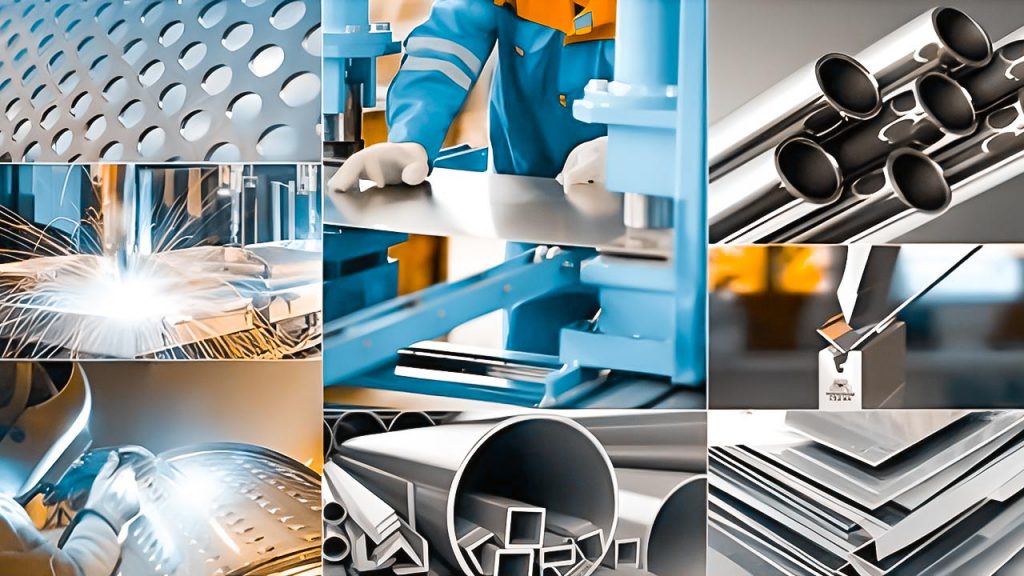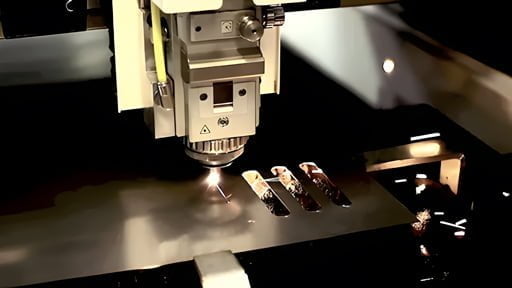Every day, we need metals. The usage of metal products in our day-to-day lives, whether personal or professional, is endless. With growing usage comes growing manufacturing demand in efficient ways. One of the most common means of metal manufacturing is the “sheet metal fabrication process.”

The process of making things out of sheet metal has gotten better over the years. The manufacturing industry has advanced extensively, especially regarding the sheet metal fabrication process. Because of this progress, there are now many advanced ways to make metal that increase productivity and cut costs. Different types of sheet metal fabrication processes use different manufacturing methods to shape metal sheets into the desired shape.
Below, we will discuss every process/detail involved in this process. So if this is your first time learning about the sheet metal fabrication process, keep reading.
What is Involved in Sheet Metal Processing or Fabrication?
If you’re unfamiliar with the different ways and guidelines one should consider during the sheet metal fabrication process, below are a few details you should consider:
- In sheet metal fabrication or sheet metal processing, flat steel or aluminum sheets are cut, punched, bent, and put together to make metal structures or items. The machine used for the sheet metal process can slice, fold, or stretch sheet metal to create the desired ready-to-use metal shape.
- These sheet metals are usually made of stainless steel, aluminum, zinc, or copper and are around 0.006 to 0.25 inches thick. Therefore, a thick gauge is used for efficient sheet metal processing using thicker materials. The thicker gauges are better for conducting sheet metal processes on heavy-duty parts with demanding uses, while thinner gauges can be used for processing lighter metal parts.
- Moreover, unique tools like band saws and chop saws are also used during the sheet metal fabrication process. This step makes sure that the machine cuts evenly throughout the whole process. Whereas the usage of cutting torches can cut large pieces of sheet metal quickly and well, making the process more efficient and budget-friendly. Another typical product used in the sheet metal fabrication process is press brakes. These press brakes help make sharp curves and angles in metal, adding more convenience to making things out of sheet metal. However, with the different types of press brakes, it is essential to understand the tasks and uses of each press brake to handle the sheet material processing efficiently and create different metal parts.
- Welding is another crucial part of making things out of sheet metal. After making all the parts, it puts them together and tack-welds them. Manufacturers can use different welding techniques to avoid warping and other problems when making sheet metal. Some of these methods are sanding the metal while it is still hot, a unique way to straighten it, staggered welding, and using a firm fixture.
Industrial Benefits of Sheet Metal Processing:
- Flexibility: Sheet metal design options are very flexible. Clients can say that they want something to do a certain thing, and you can use sheet metal materials to make many different things.
- Prototypes: Making just one prototype or many of them are possible. Modern ways of making things, like 3D printing, have short lead times that are perfect for prototyping. But these methods are only used for prototyping.
- Mass Production: Certain types of sheet metal fabrication processes can be used to move slowly from prototyping to mass production. Making prototypes sets the standards and goals for larger quantities by putting in place the necessary infrastructure.
- Flexible Finishing Options: There are many different surface finishes. These are painting, powder coating, galvanizing, plating, etc. This lets you have many different looks and uses for sheet metals.
Types of Fabricated Metal Sheets and Their Uses:
- Cold-Rolled Steel: Cold-rolled steel isn’t too expensive. It is rolled at room temperature, as the name suggests. Cold-rolled steel can only be 3 mm thick, but its surface is smoother. So it works well in places where a smooth finish is needed. Home appliances, furniture, lockers, and cabinets are all excellent examples. Larger buildings, like steel sheds and garages, also use cold-rolled steel.
- Hot-Rolled Steel: Hot-rolled steel is made when the steel is hot. When you compare hot-rolled steel to cold-rolled steel, hot-rolling makes it easier to shape, which makes the price even lower. For the same reason, thicker sheets and plates are only available in the hot-rolled form. On the other hand, the sizes of hot-rolled steel are not as precise. After being rolled, the metal cools and gets smaller. This leads to high-stress areas, which can bend the material and cause measurement changes.
- Stainless Steel Sheets: Stainless steel sheets work well in places with a lot of corrosion and where strength is also essential. Most of the time, it is used for surgical tools, kitchen tools, sinks, etc. Still, things like storage tanks, valves, and pipes, are all widely used in the industrial world.
- Aluminum Sheets: Aluminum sheets might not be used by every engineer because they are more expensive. Still, aluminum is used a lot in business applications because of its unique qualities.
Sheet Metal Fabrication Process: The Types and How They Performed

Cutting
Cutting sheet metal process is one of the three most common ways to work with metal. Sheet metal fabrication is subtractive manufacturing, like CNC machining, because it makes usable parts by cutting away pieces of metal material.
Sheet metal can be cut with various machines and types of sheet metal fabrication processes, some of which are made just for cutting sheet metal. It includes:
- A highly convenient and effective way to cut metal sheets is with a laser. A lens is used to focus the light from a powerful laser so that it can cut things. Even though it might have trouble with the most rigid materials, it is a precision sheet metal cutting process that uses little energy and works well with thin and medium gauge sheet metal.
- The sheet metal cutting process can also be done with a water jet. The metal is cut with a high-pressure water jet in this method for making things out of sheet metal. Water jet cutters are the best way to cut thin metal sheets with low melting points because they don’t make heat, which could cause the metal to warp.
- Plasma cutting is a third approach used in the sheet metal cutting process. A plasma cutter makes a hot plasma jet that quickly cuts through even thick gauges of metal sheets by making an electrical channel of ionized gas.
Deformation
Deforming sheet metal is another vital part of making things out of sheet metal. In this group of techniques, there are different ways to change and work during sheet metal processing without cutting it. These ways include:
- Bending sheet metal is one of the most common ways to change its shape. For example, a brake machine can bend sheet metal into V-shapes, U-shapes, and channels up to 120 degrees. Thinner gauge sheet metal is easier to bend.
- Stamping is another type of deformation used in the sheet metal process. It involves the usage of a hydraulic or mechanical stamping press with a tool and dies. It works like punching, but the material isn’t taken away permanently. Stamping can be used for curling, sketching, embossing, flanging, and hemming metal during the sheet metal fabrication process.
Assembly
Apart from cutting and deformation, assembling is the third approach involved in the sheet metal manufacturing process and usage of these sheets. You can perform this step with or without standard fasteners.
Using fasteners like bolts, screws, and rivets to put together different sheet metal parts is an integral part of the whole sheet metal manufacturing process, even though it is often not considered a fabrication process.
Moreover, welding is a way to join two pieces of sheet metal together, making it a practical assembly approach. In this process, heat is used to melt a part of the metal where it connects to another piece. Finally, the molten metal of the two parts joined together to make a strong connection. Common sheet metals like stainless steel and aluminum are easy to weld. However, some metals may weld better with arc, electron beam, resistance, and other types of welding.
Finishing
Once the sheet metal fabrication process is done, the final stage involved in this process is finishing. The surfaces and edges are usually polished during this process, and different coatings, such as powder coating, are added.
The sheet metal finishing process involves coating it to make it look better or last longer. Surface finishing removes a layer from the material to make it look or work better.
There are different ways to finish metal that has been made. One of the most common is anodizing, an electrochemical process that coats the surface of a metal part with oxide to make it less likely to rust.
Conclusion:
For further details and queries about the sheet metal fabrication process, feel free to connect with our professionals at Prototool.










